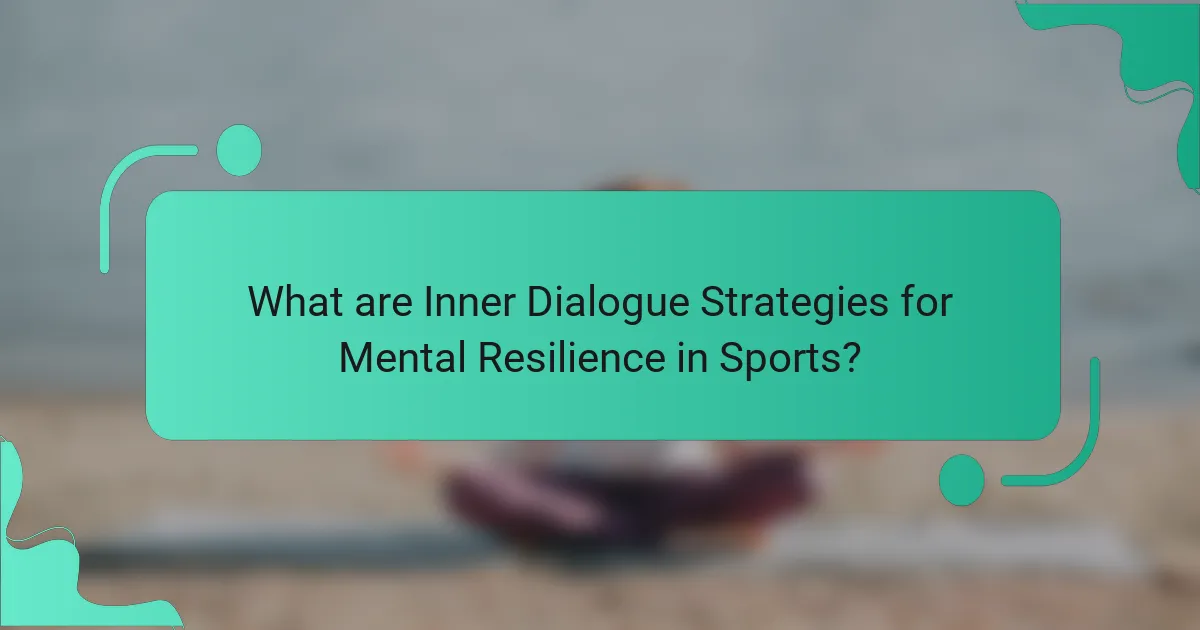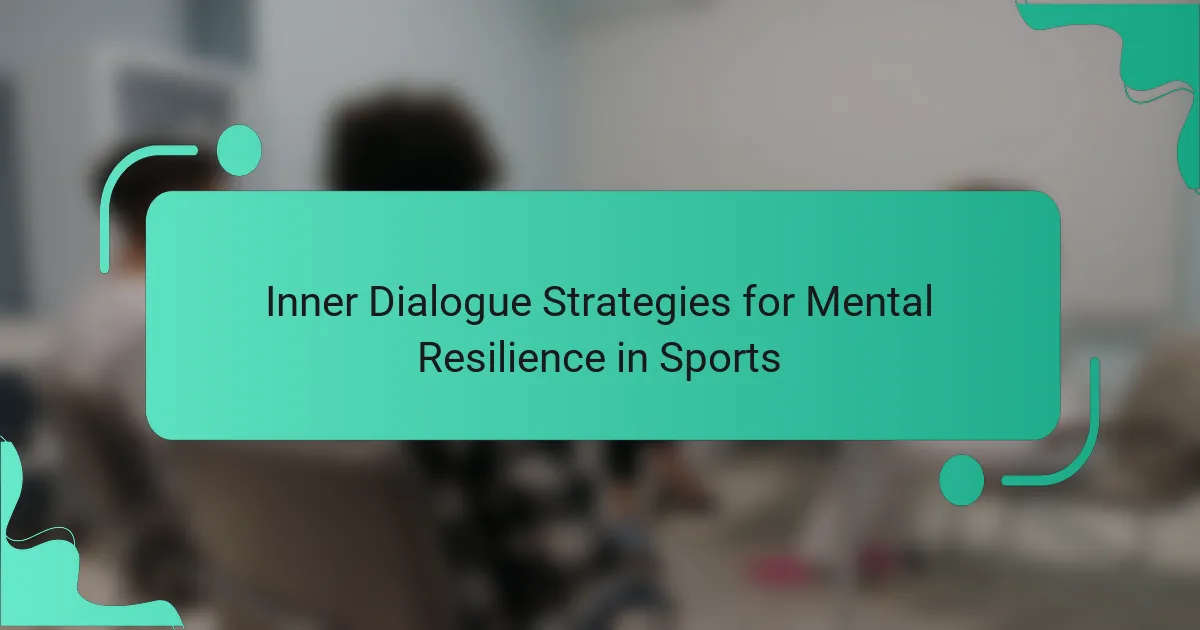Inner dialogue strategies are essential for enhancing mental resilience in sports. Techniques such as positive self-talk, visualization, and mindfulness help athletes manage pressure and improve performance. By cultivating self-awareness and adaptability, athletes can replace negative thoughts and maintain focus during competition. These strategies lead to reduced anxiety and better overall outcomes in sports.

What are Inner Dialogue Strategies for Mental Resilience in Sports?
Inner dialogue strategies enhance mental resilience in sports by fostering positive self-talk and constructive thinking. Techniques include reframing negative thoughts, using affirmations, and visualizing success. These methods help athletes manage pressure, improve focus, and maintain motivation. Research indicates that athletes employing these strategies experience better performance outcomes and reduced anxiety levels. By cultivating a strong inner dialogue, athletes can navigate challenges more effectively and boost their overall mental toughness.
How does inner dialogue impact athletic performance?
Inner dialogue significantly influences athletic performance by shaping mental resilience. Positive self-talk enhances focus and motivation, while negative thoughts can hinder performance. Athletes using constructive inner dialogue strategies report improved confidence and reduced anxiety. Research indicates that athletes with strong mental resilience often outperform those who struggle with negative self-talk patterns.
What are the common types of inner dialogue used by athletes?
Athletes commonly use three types of inner dialogue strategies: positive self-talk, motivational affirmations, and analytical self-reflection. Positive self-talk involves encouraging statements that boost confidence and focus. Motivational affirmations reinforce belief in abilities and goals. Analytical self-reflection assesses performance and identifies areas for improvement. These strategies enhance mental resilience and performance in sports.

What are the universal attributes of effective inner dialogue strategies?
Effective inner dialogue strategies for mental resilience in sports share universal attributes such as self-awareness, positive reinforcement, and goal orientation. These attributes empower athletes to maintain focus under pressure and enhance performance.
Self-awareness enables athletes to recognize negative thoughts and replace them with constructive ones. Positive reinforcement involves affirmations that build confidence and motivation. Goal orientation helps athletes visualize success, directing their inner dialogue toward achieving specific outcomes.
These attributes collectively contribute to a resilient mindset, essential for overcoming challenges in competitive sports.
How can positive self-talk enhance mental resilience?
Positive self-talk significantly enhances mental resilience by fostering a supportive inner dialogue. This practice helps athletes maintain focus, manage stress, and recover from setbacks. For example, replacing negative thoughts with affirmations can boost confidence and motivation. Research indicates that athletes who engage in positive self-talk experience improved performance and lower anxiety levels. By consistently applying these strategies, individuals can strengthen their mental fortitude in competitive environments.
What role does visualization play in inner dialogue?
Visualization enhances inner dialogue by providing mental imagery that reinforces positive self-talk. This technique helps athletes build mental resilience, enabling them to visualize success and overcome challenges. By creating vivid mental scenarios, athletes can improve focus and confidence, ultimately leading to better performance. Studies indicate that effective visualization can lead to a 20% improvement in performance metrics, highlighting its significance in sports psychology.
How do athletes use affirmations to build resilience?
Athletes use affirmations to enhance mental resilience by reinforcing positive self-talk and focusing on their strengths. This practice helps them manage stress and maintain motivation during challenges. Regular use of affirmations can lead to improved performance and a stronger mindset. For instance, a study found that athletes who engaged in daily affirmations reported higher levels of confidence and reduced anxiety. By integrating affirmations into their training routines, athletes cultivate a resilient inner dialogue that supports their overall mental health and performance.

What unique attributes differentiate successful inner dialogue strategies?
Successful inner dialogue strategies are distinguished by their focus on positive reinforcement, self-awareness, and adaptability. Positive reinforcement enhances motivation, while self-awareness allows athletes to recognize and adjust their thought patterns. Adaptability enables the application of different strategies based on situational demands. Unique attributes include personalized affirmations that resonate with individual experiences, and rare instances of mindfulness techniques specifically tailored for high-pressure environments. These elements contribute to improved mental resilience and performance in sports.
How do elite athletes tailor their inner dialogue for specific sports?
Elite athletes tailor their inner dialogue to enhance focus and motivation for their specific sports. They utilize personalized affirmations that resonate with their unique challenges and goals.
For instance, a sprinter may emphasize speed and power through phrases like “I am explosive,” while a marathon runner might focus on endurance with “I can push through.” This strategic inner dialogue fosters mental resilience, allowing athletes to overcome obstacles and maintain peak performance.
Additionally, elite athletes often practice visualization techniques alongside their tailored affirmations. By mentally rehearsing successful performances, they create a strong mental framework that supports their physical training. This combination of affirmations and visualization is crucial for achieving optimal results in their respective sports.
What are the psychological techniques unique to high-pressure situations?
High-pressure situations require specific psychological techniques to enhance mental resilience in sports. Key strategies include visualization, positive self-talk, and breathing exercises.
Visualization involves mentally rehearsing successful performances, which can boost confidence and focus. Positive self-talk helps athletes maintain motivation and counter negative thoughts. Breathing exercises regulate emotional responses, promoting calmness and clarity under pressure.
These techniques are essential for athletes aiming to perform at their best when stakes are high.

What rare attributes can enhance inner dialogue strategies?
Rare attributes that can enhance inner dialogue strategies include mindfulness integration, emotional granularity, and cognitive flexibility. Mindfulness integration allows athletes to stay present, reducing anxiety. Emotional granularity helps in precisely identifying feelings, promoting effective self-talk. Cognitive flexibility enables quick adaptation of thoughts, fostering resilience. These attributes collectively strengthen mental resilience in sports.
How do cultural factors influence inner dialogue in sports?
Cultural factors significantly shape inner dialogue in sports by influencing athletes’ beliefs and mental strategies. Cultural norms dictate how athletes perceive competition, success, and failure, impacting their self-talk. For instance, collectivist cultures may emphasize team success, leading to supportive inner dialogue, while individualistic cultures might foster self-reliance, resulting in critical self-talk.
Additionally, cultural attitudes toward mental health affect how athletes approach their inner dialogue. In cultures where mental resilience is valued, athletes may engage in positive affirmations and visualization techniques. Conversely, cultures that stigmatize mental struggles may lead to negative self-talk and avoidance of mental strategies.
Understanding these cultural influences allows athletes to tailor their inner dialogue strategies, enhancing mental resilience and performance. By recognizing and adapting to their cultural context, athletes can develop a more constructive and supportive inner voice.
What uncommon techniques do top performers use for mental resilience?
Top performers use visualization, positive affirmations, and reframing techniques for mental resilience. Visualization involves creating mental images of success, enhancing focus and confidence. Positive affirmations reinforce self-belief, while reframing helps athletes view challenges as opportunities. These strategies cultivate a strong inner dialogue, essential for peak performance.

How can athletes implement these strategies in their training?
Athletes can implement inner dialogue strategies by integrating positive self-talk, visualization techniques, and mindfulness exercises into their training routines. Positive self-talk enhances confidence and focus, while visualization helps athletes mentally rehearse performance. Mindfulness exercises foster present-moment awareness, reducing anxiety. Regular practice of these strategies builds mental resilience over time.
What practical steps can athletes take to develop effective inner dialogue?
Athletes can enhance their inner dialogue by practicing self-awareness, positive affirmations, visualization techniques, and mindfulness. These strategies promote mental resilience and improve performance.
1. Self-Awareness: Regularly assess thoughts and emotions during training and competition to identify negative patterns.
2. Positive Affirmations: Use encouraging statements to replace self-doubt and reinforce confidence.
3. Visualization Techniques: Imagine successful performances to build mental imagery and prepare for challenges.
4. Mindfulness: Engage in mindfulness exercises to stay present, reducing anxiety and enhancing focus.
What exercises can improve self-talk?
Engaging in specific exercises can significantly enhance self-talk. Techniques such as visualization, positive affirmations, and mindfulness meditation empower athletes to foster constructive inner dialogue.
Visualization involves imagining successful performances, reinforcing confidence and focus. Positive affirmations, repeated daily, help counter negative thoughts and build resilience. Mindfulness meditation cultivates awareness of thoughts, allowing athletes to reframe negative self-talk into supportive messages.
Incorporating these practices into training routines can lead to improved mental resilience in sports.
How can athletes track their progress with inner dialogue?
Athletes can track their progress with inner dialogue by setting specific mental goals and regularly reflecting on their performance. This strategy enhances self-awareness and resilience. Athletes should practice positive affirmations to reinforce confidence and visualize successful outcomes. Regularly assessing thoughts during training and competition helps identify patterns that can be adjusted for improvement.
What are common mistakes to avoid in inner dialogue practices?
Common mistakes in inner dialogue practices include negative self-talk, lack of consistency, and ignoring emotions. Negative self-talk undermines confidence and performance. Inconsistency leads to ineffective reinforcement of positive messages. Ignoring emotions can prevent athletes from addressing underlying issues. Recognizing these pitfalls enhances mental resilience in sports.
How can coaches support athletes in developing inner dialogue strategies?
Coaches can support athletes in developing inner dialogue strategies by fostering a positive mindset. They can teach techniques such as visualization, affirmations, and self-talk to enhance mental resilience. Regular feedback and open communication help athletes identify negative thoughts and replace them with constructive dialogue. Additionally, coaches can model effective inner dialogue, demonstrating its impact on performance and emotional regulation.

What are the best practices for optimizing inner dialogue in sports?
To optimize inner dialogue in sports, athletes should focus on positive self-talk, visualization techniques, and mindfulness practices. These strategies enhance mental resilience and performance during competition.
Positive self-talk involves replacing negative thoughts with affirmations that build confidence. For example, instead of thinking, “I can’t do this,” an athlete might say, “I am prepared and capable.” This shift can significantly impact performance outcomes.
Visualization techniques help athletes mentally rehearse their performance. By imagining successful execution of skills and strategies, athletes create a mental blueprint that can translate into real-life success. Studies show that mental imagery can enhance motor skills and reduce anxiety.
Mindfulness practices, such as meditation and focused breathing, improve concentration and emotional regulation. Athletes who engage in mindfulness report better focus during high-pressure situations, leading to improved performance.
Incorporating these strategies into daily training routines can foster a more resilient mindset, enabling athletes to perform at their best under stress.
How can athletes maintain consistency in their inner dialogue strategies?
Athletes can maintain consistency in their inner dialogue strategies by establishing structured routines and self-awareness techniques. Regular practice of positive affirmations and visualization enhances focus and resilience. Monitoring inner dialogue during training helps identify negative patterns, allowing for timely adjustments. Engaging in mindfulness exercises fosters a supportive mental environment, promoting sustained motivation and confidence.
What expert insights can enhance understanding of inner dialogue?
Expert insights can significantly enhance understanding of inner dialogue by emphasizing its role in mental resilience for athletes. Techniques such as cognitive restructuring can help athletes reframe negative thoughts, fostering a more positive mindset. Visualization strategies enable athletes to mentally rehearse successful performances, strengthening their confidence. Regular mindfulness practice encourages present-moment awareness, reducing anxiety and improving focus. Additionally, self-talk techniques can cultivate a supportive inner voice, promoting motivation and resilience during competitive challenges. These strategies collectively empower athletes to harness their inner dialogue for improved performance and mental well-being.
